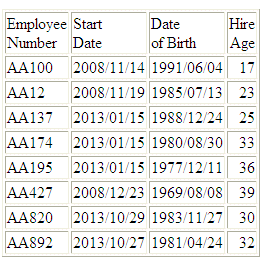DTDIFF(end_date, start_date, component)
where:
- end_date
Date or date-time
Is the ending date in either standard date or date-time format. If this date is given in standard date format, all time components are assumed to be zero.
- start_date
Date or date-time
Is the starting date in either standard date or date-time format. If this date is given in standard date format, all time components are assumed to be zero.
- component
Keyword
Is the component on which the number of boundaries is to be calculated. For example, QUARTER finds the difference in quarters between two dates. Valid components (and acceptable values) are:
- YEAR (1-9999)
- QUARTER (1-4)
- MONTH (1-12)
- WEEK (1-53). This is affected by the WEEKFIRST setting.
- DAY (of the Month, 1-31)
- HOUR (0-23)
- MINUTE (0-59)
- SECOND (0-59)
The following request against the WF_RETAIL data source calculates employee age when hired:
DEFINE FILE WF_RETAIL YEARS/I9 = DTDIFF(START_DATE, DATE_OF_BIRTH, YEAR); END TABLE FILE WF_RETAIL PRINT START_DATE DATE_OF_BIRTH YEARS AS 'Hire,Age' BY EMPLOYEE_NUMBER WHERE EMPLOYEE_NUMBER CONTAINS 'AA' ON TABLE SET PAGE NOPAGE END
The output is:
